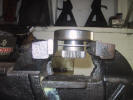
To remove the 6207 bearing from the splined bushing,
open the jaws of a vise enough to rest the outer race of the bearing
on the jaws... |

...use a tommy bar and hammer to tap around the inner
face of the splined bushing until it drops through the bearing. Have
something soft for the splined bushing to land on so it does not
damage the splines. |

Here are the 3 pieces separated; the 6207 bearing,
washer and splined bushing.
Check bearing for serviceability and replace if
needed. |
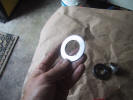
Examine the front and... |

..back of the washer for grooving or heavy wear.
This washer is reuseable. |
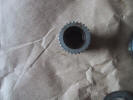
Examine the splined bushing out teeth (these mate to
the splines of the wheel hub) for excessive wear. The teeth should
be square and smooth... |
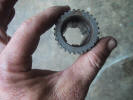
examine the inner splines (these lock with the
splines on the short axle) for wear and galling.
This is a good bushing. |
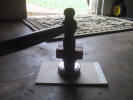
To install a new 6207 bearing, set the bearing on a
hard surface, place the washer on next and then carefully start the
splined bushing into the bearing taking great
care not to cock the bushing in the bearing. Then use a block
of wood to drive the bushing through the bearing...
|
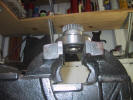
...then set the bearing on the open jaws of a vise so
the outer edge of the inner race is just supported... |
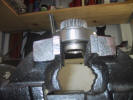
...then finish driving the splined bushing fully
through the bearing using the block of wood and hammer. |

The splined bushing and 6207 bearing are now ready to
be installed. |

The drive shaft fork assembly has an 38 X 3 mm O-ring
that should be replaced when the assembly is removed. |

Use a pick or thin screw driver to remove the old
O-ring... |

Use some silicone grease on the new O-ring and slide
it into the groove. |
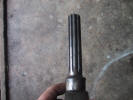
Examine the splines of the driveshaft fork for wear.
The splines should be square, even and sharp, having no excessive
wear.
This splined shaft is good. |
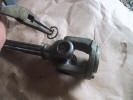
To replace the U-joint or disassemble a non zerk
equipped joint for servicing, use a pair of needle nose pliers to
squeeze and remove the retaining clips... |
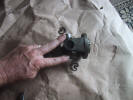
...of two opposing cross cups. |

Use a 15mm socket and hammer to drive the cross
through the yoke...
If a grease zerk is installed,
position the zerk so that it is being driven toward the center of
the cross and not toward the yoke. Zerk is just visible above lower
yoke. |
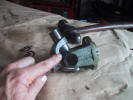
...grease zerk is here, if you attempt to drive the
cross through the other way...the zerk will be forced against the
yoke above and jam/break... |

...tap the cross through just enough to drive the
opposing cup out enough... |
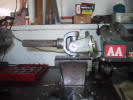
...so that you can grip it in the jaws of a vise. |
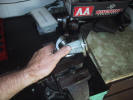
Work it back and forth with a slight pull up to
remove the cup... |
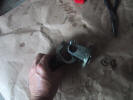
...then turn the fork down and press the cross arm
through where the cup was removed... |

...enough to clear the opposing cup and separate the
two yokes. |

Now do the same with the last half of the cross.
Remove the 2 remaining retaining clips... |
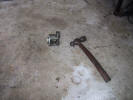
...you can start the cross through by setting it on a
hard surface and using the socket and hammer. Then just pick it up
in your hand like before and tap the cup out enough to grab with the
vise. |
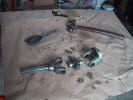
Driveshaft fork assembly fully dismantled.
If you do not have U-joints with zerks, you can
now clean and repack the needle bearings for reassembly.
|

If you are replacing the U-joint, I recommend using a
Precision #341 as it is fitted with a grease zerk and will provide a
longer service life if maintained. |

Here is what you get for $30. |
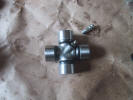
The long zerk fitting that comes with the U-joint
will not work. The long zerk hits the inside of the yoke and will
break. You must get a short zerk and install it. |
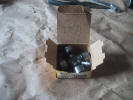
Put the old U-joint in the box and save them as you
can possibly use the old parts if the new joint gets damaged during
assembly or while in service. |
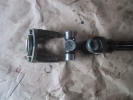
When assembling the joint, you want to think about
zerk placement. You want the zerk in such a position that you can
get to it for greasing. If the zerk were to go in the opposite of
above, it would be difficult if not impossible to get a grease
fitting on it. |

Use the needle nose pliers to install one of the
retaining clips in the yoke. This will prevent you from driving the
cross/cup too far through the yoke when installing. If this were to
happen, it would damage the cups and seals. |

Remove the cup next to the zerk... |

...insert the cross into the yoke hole without the
retainer clip and push it up enough to get the opposing cross with
cup over the yoke hole with the retaining clip in place. |

Press the removed cup into the yoke hole with finger
pressure. Make sure it is square to the hole and not cocked... |

Turn the yoke over so the retaining
clip side is facing up. Place the yoke on a
hard surface and while keeping the bottom cup flat on the surface,
tap the top of the yoke to drive the bottom cup into the yoke. |
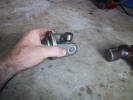
The bottom cup is now flush to the yoke hole... |

...the other cup is now almost seated against the
retaining clip, turn it back over to the flush side... |

...and take a 15mm socket and the hammer... |

and finish driving the cross through until... |
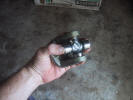
...the opposing cup seats against the retaining clip. |
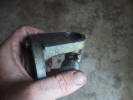
Before going any further, check for smooth movement
of the cross. If it binds or is very difficult to move, something is
wrong. Take it apart and check that one or more of the needle
bearings did not get pushed to the bottom of a cup or that one of
the seals got buggered. This is where the old parts may come in
handy. |
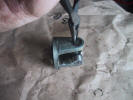
If the joint articulated smoothly, pop the retaining
clip in. |

Now we can install the splined shaft yoke. |
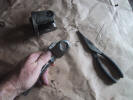
Install one retaining clip into the splined shaft
yoke... |

Remove a cup of the cross, insert the cross into the
yoke hole without the retaining clip... |
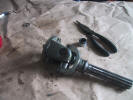
...push the cross up into the hole until you can
angle the opposing cross with cup over the hole in the splined yoke
with the retaining clip in place. |

Check that the cross is centered in the hole... |

...and then press the last cup into place using
finger pressure only, maybe a light tap with the hammer. |
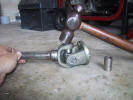
Place the driveshaft fork assembly on a hard surface
with the exposed cup facing down. Using a hammer, tap the top of the
yoke until the cup is flush with the yoke against the floor/surface. |

A view showing the zerk and the upper cup almost
seated against the retaining clip... |

...flip the assembly over so you are looking a the
flush cup.... |

...place the 15mm socket on top and ... |
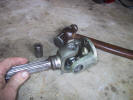
...tap the cup through until the opposing cup seats
against the retaining clip.
Check for smooth movement of the joint is all
directions. If there is a problem, disassemble the affected side and
inspect. |

If all is well, put the last retaining clip into
place. |

The driveshaft fork assembly is now ready to install.
Note the position of the zerk. It will be easy to
access after installation.
New U-joints must be greased after
installation and before driving the motorcycle!!!! |
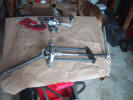
The easiest way to remove the 6206 bearing from the
sidecar short axle is to remove the U-joint, set the axle upright on
the open jaws of a vise and hammer the axle through the bearing and
dust cover. However, this U-joint was in good shape and did not need
replacement. So a bearing separator was used to pull the bearing
free. |
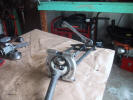
This is the same Pittsburgh #93980 bearing separator
kit as used in Chapter 7.8, Pinion Gear Disassembly, and can
be purchased at Harbor Freight.
This is a view from the driveshaft end...
|

...and one from the short axle end after the 6206
bearing and dust cover were pulled free. It took 10 minutes to set
up and 30 seconds to pull.
Again, if replacing this U-joint, it is simple to
use the vise as explained above to drive the axle through the
bearing. It almost takes the same amount of time. |

Bearing and dust cover removed. If the short axle is
worn or galled, it must be replaced. |
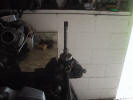
To install the new 6206 bearing, clamp the short axle
yoke in a vise, slip the dust cover and bearing on...
Note: If you removed the U-joint,
this would be how you would remove the bearing by setting the
bearing on the open vise jaws and tapping the axel through the
bearing. |

...use a block of wood and a hammer to seat the
bearing. I toss an old flywheel lock washer over the top of the
bearing just to protect the bearing seal...always save those old
worn out parts...they come in handy. |

Short axle and driveshaft ready to be installed. |
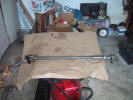
Here is the driveshaft laid out with the driveshaft
fork assembly inserted into the driveshaft (right side). Make sure
when you assemble the driveshaft on the motorcycle that the yokes
are "in phase" or in alignment with each other. Note how the inside
left yoke and the yoke of the fork assembly on the right are "mirror
image" or matched to each other. |
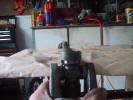
The yokes must be in-line with each other or as the
driveshaft turns it will be unbalanced and bend the driveshaft and
place undue wear and tear on the U-joints and bearings.
Looking down across the top of the two U-joints
there is about 1/4" of twist. This is caused from "flying chair" and
abuse which twists the soft metal of the shaft. Bends and twists
like this can be hammered/twisted out. In severe cases a new shaft
can be welded to the yokes or the unit can be replaced. |

While the driveshaft is out, it is much easier to
grease the U-joints.
I use a Lubrimatic Needle Tip Adapter #11867 which
is available at Sears and most automotive stores. |
|
|
|